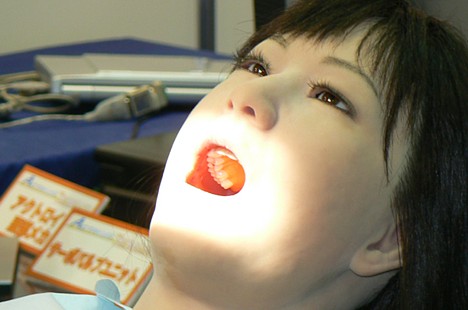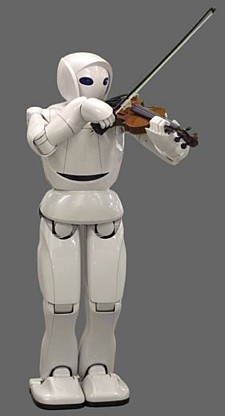Dec 08, 2007
The emergence of motor imagery in children
The emergence of motor imagery in children.
J Exp Child Psychol. 2007 Nov 28;
Authors: Molina M, Tijus C, Jouen F
18:13 Posted in Mental practice & mental simulation | Permalink | Comments (0) | Tags: mental practice, mental simulation
Dec 07, 2007
Toyota unveils robot violinist
14:03 Posted in AI & robotics | Permalink | Comments (0)
Dec 04, 2007
The analgesic effects of opioids and immersive virtual reality distraction
The analgesic effects of opioids and immersive virtual reality distraction: evidence from subjective and functional brain imaging assessments.
Anesth Analg. 2007 Dec;105(6):1776-83, table of contents
Authors: Hoffman HG, Richards TL, Van Oostrom T, Coda BA, Jensen MP, Blough DK, Sharar SR
BACKGROUND: Immersive virtual reality (VR) is a novel form of distraction analgesia, yet its effects on pain-related brain activity when used adjunctively with opioid analgesics are unknown. We used subjective pain ratings and functional magnetic resonance imaging to measure pain and pain-related brain activity in subjects receiving opioid and/or VR distraction. METHODS: Healthy subjects (n = 9) received thermal pain stimulation and were exposed to four intervention conditions in a within-subjects design: (a) control (no analgesia), (b) opioid administration [hydromorphone (4 ng/mL target plasma level)], (c) immersive VR distraction, and (d) combined opioid + VR. Outcomes included subjective pain reports (0-10 labeled graphic rating scales) and blood oxygen level-dependent assessments of brain activity in five specific, pain-related regions of interest. RESULTS: Opioid alone significantly reduced subjective pain unpleasantness ratings (P < 0.05) and significantly reduced pain-related brain activity in the insula (P < 0.05) and thalamus (P < 0.05). VR alone significantly reduced both worst pain (P < 0.01) and pain unpleasantness (P < 0.01) and significantly reduced pain-related brain activity in the insula (P < 0.05), thalamus (P < 0.05), and SS2 (P < 0.05). Combined opioid + VR reduced pain reports more effectively than did opioid alone on all subjective pain measures (P < 0.01). Patterns of pain-related blood oxygen level-dependent activity were consistent with subjective analgesic reports. CONCLUSIONS: These subjective pain reports and objective functional magnetic resonance imaging results demonstrate converging evidence for the analgesic efficacy of opioid administration alone and VR distraction alone. Furthermore, patterns of pain-related brain activity support the significant subjective analgesic effects of VR distraction when used as an adjunct to opioid analgesia. These results provide preliminary data to support the clinical use of multimodal (e.g., combined pharmacologic and nonpharmacologic) analgesic techniques.
08:58 Posted in Cybertherapy, Virtual worlds | Permalink | Comments (0) | Tags: virtual reality, cybertherapy
Simroid
Via Pink Tentacle

Simroid is a robotic dental patient designed by Kokoro Company Ltd as a training tool for dentists.
The simulated patient can follow spoken instructions, closely monitor a dentist’s performance during mock treatments, and react in a human-like way to mouth pain thanks to mouth sensors.
08:37 Posted in AI & robotics | Permalink | Comments (0) | Tags: robotics, artificial intelligence
Prosthetic Limbs That Can Feel
Via KurzweilAI.net
Researchers at Northwestern University, in Chicago, have shown that transplanting the nerves from an amputated hand to the chest allows patients to feel hand sensation there.
The findings are the first step toward prosthetic arms with sensors on the fingers that will transfer tactile information from the device to the chest, making the wearer feel as though he or she has a real hand.
Full article here
08:29 Posted in Neurotechnology & neuroinformatics | Permalink | Comments (0) | Tags: neurotechnology, neuroinformatics
Google Maps for mobile
08:24 Posted in Locative media | Permalink | Comments (0) | Tags: locative media







